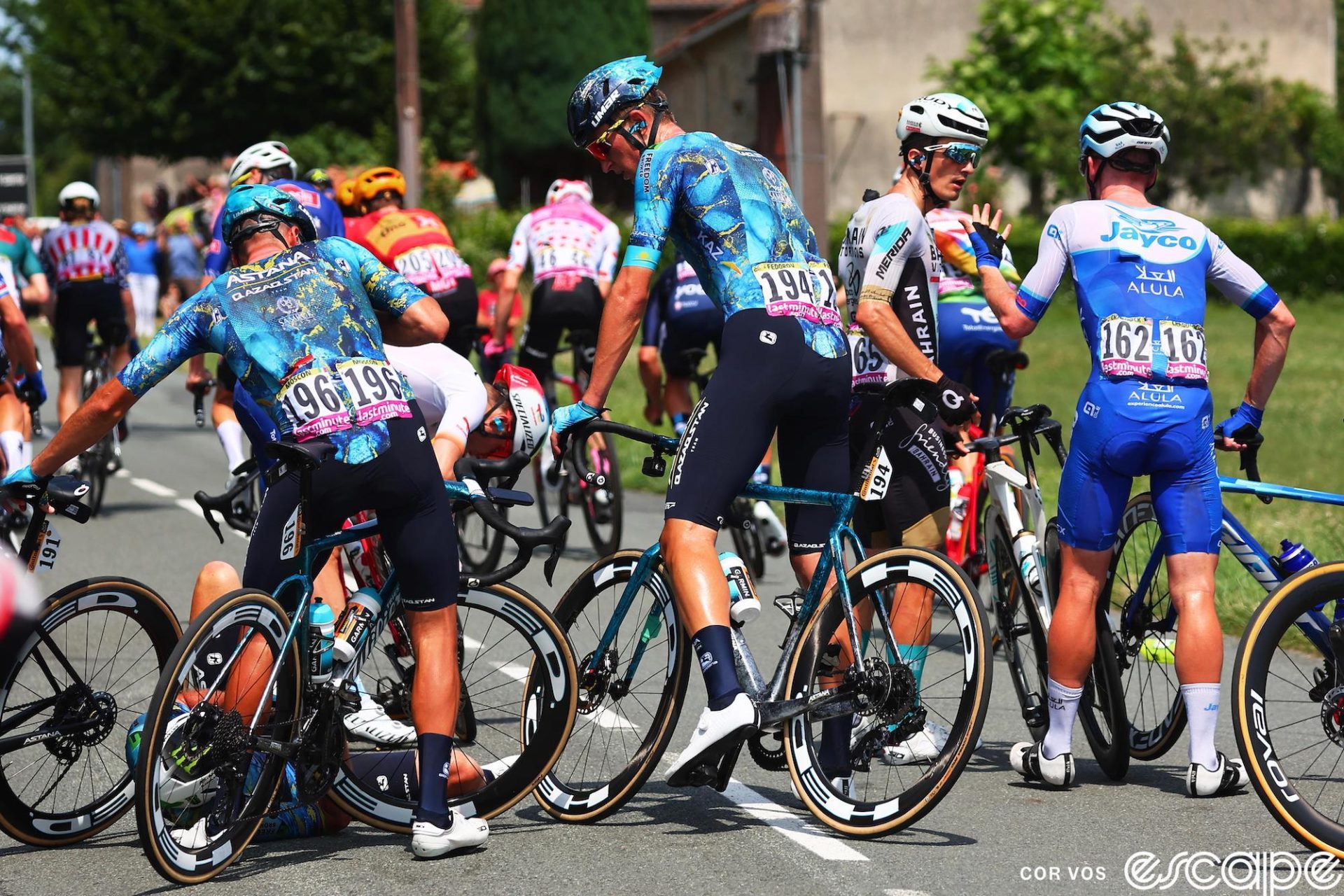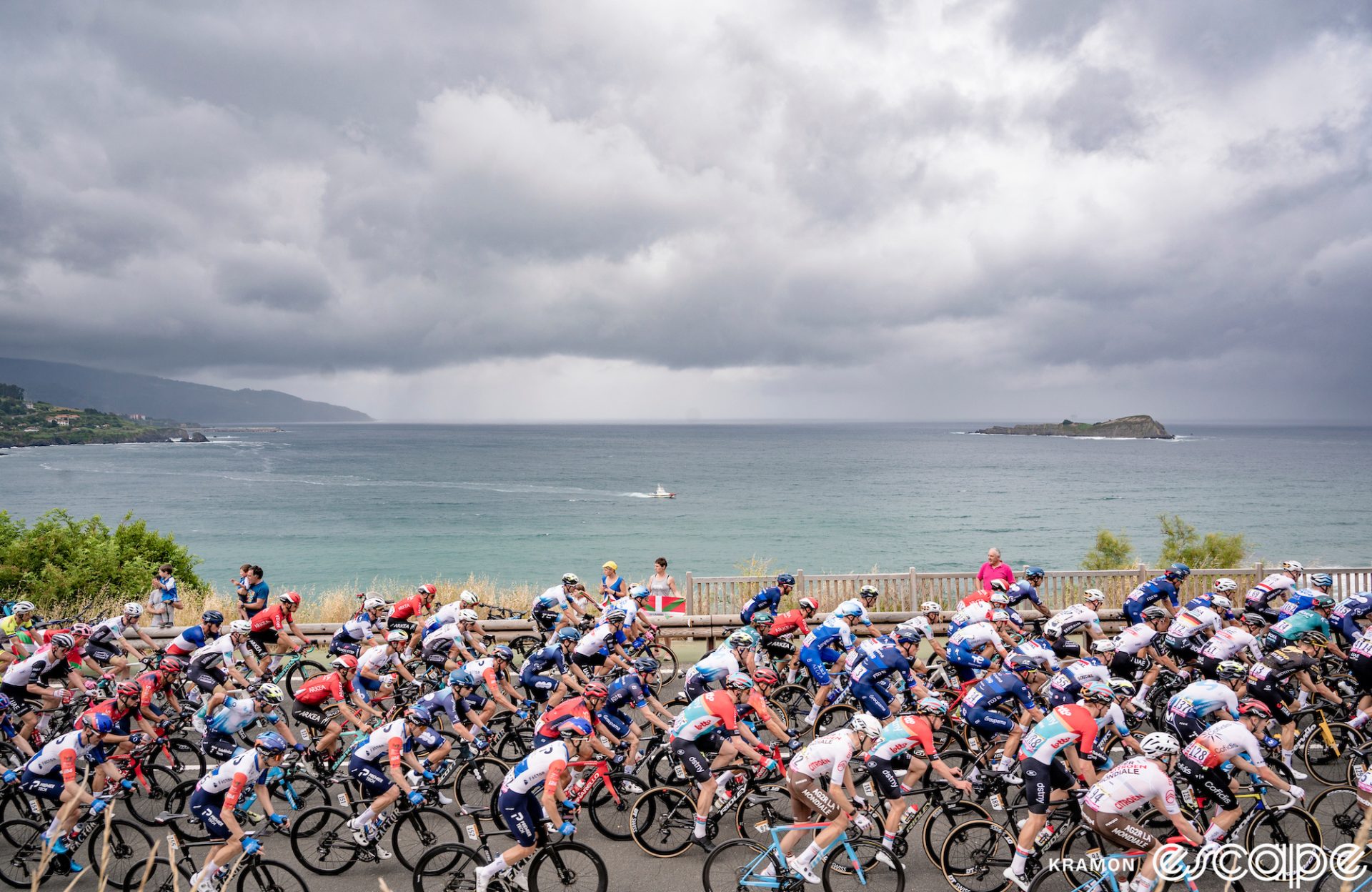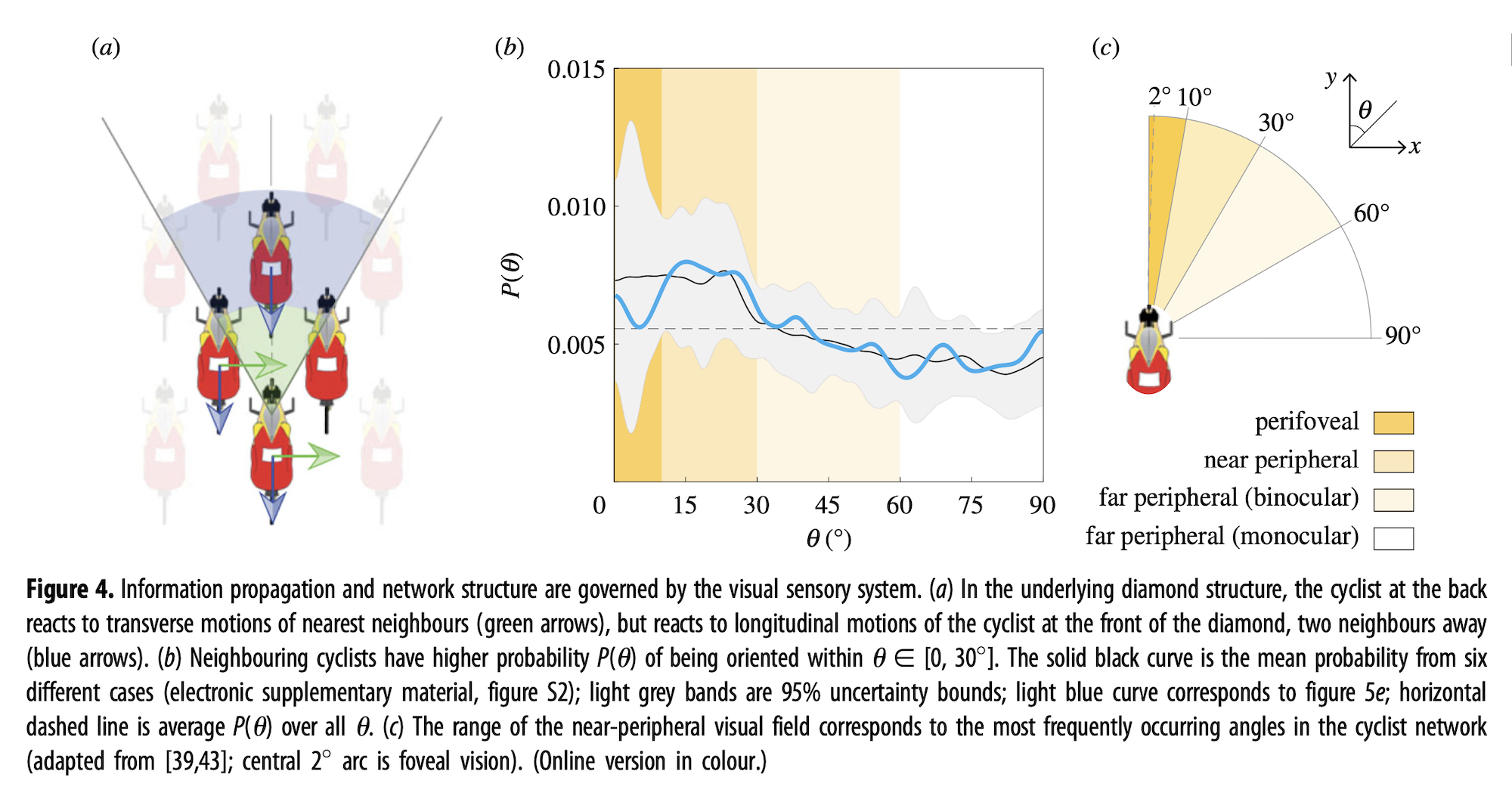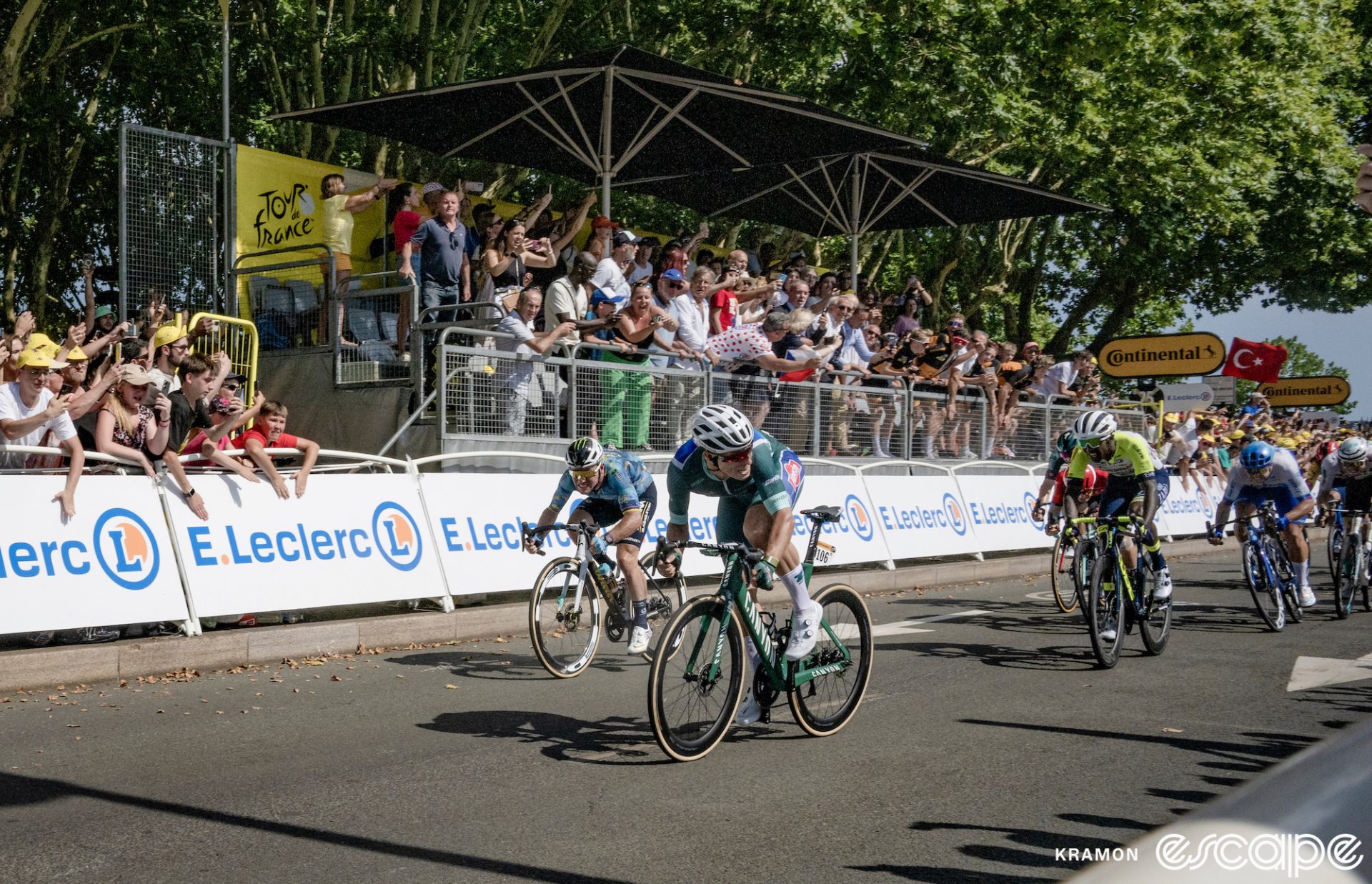It began as an almost imperceptible ripple, a brief touch of shoulders between two riders in the pack on the left side of a straight, flat road, and a touch of the brakes. But as the wave shot backward through the peloton, its size and power grew rapidly.
Farther back in the bunch, two riders each with a hand off the bar to take a drink nearly careened into riders in front of them as the group suddenly slowed. As the group compressed to absorb the change in momentum, the wave finally crashed at the very back, as a touch of wheels sent a handful of riders hurtling to the tarmac. When the melee cleared, one stayed down, clutching his right shoulder.
On one level, the crash that knocked Mark Cavendish out of the Tour de France on stage 8 was a senseless, inexplicable tragedy, especially coming a day after he’d come within a skipping drivetrain of a record-breaking 35th stage win. On another, it was entirely predictable; a textbook example of the risks of longitudinal wave propagation within a swarm.
Wait, what?

For pro road cyclists, the peloton is many things, but none more important than shelter. So it stands to reason that it resembles the collective herd behavior of other animal species – fish, birds, many ungulates – that gather together in numbers for safety. This is more than just an analogy. A peloton operates under the same broad rules as other dense groups of animals, says Marina Papadopoulou, a computational biologist at Swansea University who studies animal collective behavior.
“The main connecting idea is self-organization,” she explains, which means “interactions between individuals, and with different interacting neighbors that overlap each other.” Those interactions produce a kind of information that travels through the pack, “like ‘a predator is coming,’ so the animals all turn right,” Papadopoulou says. Essentially: a ripple effect, where communication between two individuals spreads throughout a group following basic rules of attraction, alignment, and avoidance, and becomes collective action.
In cyclists, as in other animals, those cues are primarily visual. Sometimes riders will point out a road hazard, but the general rule, says Michael Mørkøv, Soudal Quick-Step’s leadout man extraordinaire, is keep your hands on the bar. “If you take a hand off and something happens, you go down immediately,” he says.
Visual information processing is not a hard rule; even though bats see quite well, they navigate by echolocation, and some schooling fish can sense pressure changes in current around them. And riders certainly do talk at times, but not when the race is really popping. “It’s impossible,” says Mørkøv of verbal communication when trying to set up a sprint. “Everything has to be really dialled in before. That’s why it’s important to know each other real well. You have to speak before the race, because you cannot yell your teammates up. If you try on the radio, it’s too noisy.”

It’s hard to beat a good pair of eyes; one 2014 study on starling murmurations, those massive flocks that wheel and arc in such dense gatherings that they blot out the sky, found that each starling may keep close track of as many as seven other birds in its immediate vicinity.
Humans have excellent vision, particularly motion sensitivity. But, Papadopoulou points out, prey animals typically have eyes on each side of their head, which gives them a massive range of peripheral vision – as much as 340°. In eyes-front humans, it’s about half that, meaning we have to use our vision a bit differently. As it turns out, a somewhat improbable someone has studied exactly how cyclists do it.
Jesse Belden is a researcher at the Naval Undersea Warfare Center in Newport, Rhode Island. Most of his scholarly papers have titles like “Three-dimensional synthetic aperture particle image velocimetry” and the intriguing “Elastic spheres can walk on water.” But in 2019, he and some colleagues turned their attention to cyclists, with a scientific paper published by The Royal Society titled “How vision governs the collective behavior of dense cycling pelotons.”
Belden and Co. looked at hours of aerial footage from the 2016 Tour de France, identifying a basic diamond-shaped configuration of four riders that repeats in a lattice-like pattern throughout the pack. Rather than ride shoulder to shoulder, racers are staggered next to their closest neighbor.
That pattern, also often seen in birds in flight, led to the researchers’ principal theory: it’s vision and safety, not aerodynamics, that governs the structure of the pack. Cyclists, Belden wrote, “align in patterns within a +/- 30° arc corresponding to human near-peripheral visual field in order to safely accommodate motion perturbations.”

That’s just crazy, right? The benefits of drafting are irrefutable, established with decades of research, and the best draft is always in the pack, sheltered by lots of other riders. And yes, that’s the primary reason racers ride in groups. But Belden cites aerodynamic research from Bert Blocken, an engineering professor at KU Leuven and aero consultant for Jumbo-Visma, to the effect that inside the peloton, there is no particular benefit or drawback to any given spot (except on the front and windward sides). So once the pack forms, Belden writes, “local interaction principles are governed by details of visual sensory systems … sensory function shapes the moment-by-moment dynamics.”
Human reaction times to visual stimuli are around 200 milliseconds. And while we have a decently wide field of peripheral vision, most of our attention is in our much narrower perifoveal (10°) and near-peripheral (30°) view. Given those reaction times and vision, the diamond-shaped pattern offers riders the most time – and possible trajectories of travel – to avoid colliding with other riders.
Arguably the most critical time is the last 10-20 km in a sprint stage, that seething, boiling, roiling mass of riders all focused on what they call the final. Whether the break has been caught or not, speeds spike, which creates several effects. First, the pack lengthens. Again, that’s a phenomenon that Papadopoulou says is common elsewhere in animal pack behavior; when in motion, the group is usually oblong-shaped, and stretches out as it gains velocity.
As with the basic structure of the peloton, when it lengthens out into a line, it’s not only due to aerodynamics. It’s kind of a tautology, but the pack is going fast because it’s stretched out because it’s going fast. There’s a super nerdy term to explain it, called Easterbrook’s Cue Utilization Theory, and the basics are that arousal narrows your attention onto the stimulus.
“You’re trying not to lose positions, or [you’re] gaining positions,” says Uno-X sprinter Alexander Kristoff. “So you’re just really in the moment, and you’re really focused on the brakes of course because around the next corner can be some road furniture or something and it’s quite hectic.”
In this case, riders’ conscious vision literally narrows. So if, say, Soudal’s Kasper Asgreen puts in one of those massive pulls that threatens to rip the field apart, and everyone’s power output and heart rate spikes in response, they can’t keep track of their peripheral surroundings as well, and so they spread out a bit for more safety. On a road, the only way to spread out is backward.

Of course, Asgreen is not the only rider trying to make the catch or keep his sprinter up front, so it’s still usually pretty crowded. Riders know intuitively that “if someone decelerates just a bit, that change in speed is expensive,” as Papadopoulou puts it. Even if a crash is avoided, the cost can be a loss of 10 or 20 vital spots at a critical moment of the race.
That tense, kilometers-long prelude to the leadout, when the pack is flying, is also when those perturbations, or ripples, can cause the most damage, the chaos theory of a simple butterfly bump of shoulders whipping up a hurricane at the back.
There are two types of ripples: transverse and longitudinal, and they’re exactly what they sound like. A transverse perturbation travels sideways, say as a rider tries to make space to move his sprinter up in the pack around other riders. A longitudinal perturbation is what happened in the Cavendish crash, when a slowing somewhere in the pack spreads backward (always backward; the motion is never to the front). The diamond pattern helps manage both risks, but according to Belden’s research, longitudinal waves travel significantly faster, and are more dangerous.
“You have to be alert in this stage of the race,” says Lotto Dstny leadout man Jasper De Buyst of the final. “Everybody’s like, inches from each other. You cannot miss anything.” Sometimes, it goes wrong, even with animals. Sometimes, says Papadopoulou, starling murmurations trying to escape predators will dive sharply, and those at the bottom “essentially crash each other into the ground.” Or a wave rockets backward in the peloton and the winningest sprinter in Tour de France history is left crumpled on the blacktop with a broken collarbone.
There are, of course, limits to comparing riders and animals. Cyclists are not fleeing predators, and the field is also artificially hemmed in by the geometry of whatever road it is on, unlike a school of fish in open water. But broadly, it holds up. Changes in speed are expensive whether the prize is avoiding a predator or sprinting for a stage win. And given the speeds of modern pro racing, the wide variety in the racing environment (including the proliferation of road furniture) and the tight density of the pack, it says a lot about the handling skills of riders that there aren’t more mass crashes in the sport.

“At this level, you know that everyone can handle their bikes quite well and when you hit the corners, everyone takes the same kind of angle and you trust everyone’s not gonna take evasive action in the middle,” says DSM-Firmenich sprinter Sam Welsford. “One mistake can cost you everything in a sprint, so you have to be super, super focused.”
Which suggests that, while Belden makes a convincing case for the primacy of vision as a driver for pack behavior, the eyes alone may not have it. When the race is really going, says De Buyst, “You get in this phase of adrenaline where you’re aware of everything. And sometimes when it’s going really well then you just see everything slower, like you can analyze it. Your whole body is in a state of full concentration.” In a way, maybe it is a little bit like being prey, what De Buyst calls a state of total alertness, “like when you’re scared of something.” To survive and surf the swarm, you almost need eyes in the back of your head.
Jonny Long contributed reporting from on the ground at the Tour de France.
What did you think of this story?

